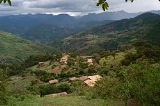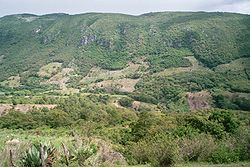
Celaque National Park
Encyclopedia
Celaque National Park is a national park
in Lempira Department, western Honduras
. It was established on 1 January 1987 and covers an area of 266.4 square kilometres. It includes Honduras’ tallest peak, called Cerro Las Minas
or Pico Celaque, which reaches approximately 2870 metres (9,416 ft) above mean sea level
. It has an elevation ranging from 975 to 2870 m (3,198.8 to 9,416 ft). Celaque’s terrain is very rugged, two-thirds of the area has a slope greater than 60 degrees. The park is classified as a cloud forest
with a mean precipitation of 1,600 mm at lower altitudes and a mean of 2,400 mm at higher altitudes. The word celaque is reputed to mean caja de aguas ("box of water(s)") in the local, but now extinct, indigenous Lenca language
. Celaque’s nine rivers supplies water to 120 villages nearby including the district capital of Gracias
. Celaque is high in biodiversity
and is home to jaguar
s, pumas, ocelot
s and Bolitoglossa celaque
, an endangered newt
found only in the mountains of Celaque. However, Celaque was not always a recognized park.

made Celaque a national park. By forming the park, some 266 square kilometres (65,730 acre) were nationally protected from logging, agriculture, outside incursion and market-related forestry exploitation.
 The success of the park was unknown until recent studies. Between the years 1987-1998 it was found that the area of open forested land decreased while mature forests became the largest forest class in the park. Forest fragmentation (measurement of area of bare patches and distances from one patch to another) decreased in areas without villages but increased in inhabited areas. However, with further examination, these results are less impressive. In the 11-year period the environment of the park had changed dramatically. These results were found in high elevations, remote and uninhabited areas of the park and in areas where the environment under examination was previously established. Meaning that the increase in mature forests was found in areas that already had mature trees but not in areas where open forest or agriculture land had been previously. Though the results of the park’s conservation efforts were positive they aren’t enough to save Celaque’s biodiversity.
The success of the park was unknown until recent studies. Between the years 1987-1998 it was found that the area of open forested land decreased while mature forests became the largest forest class in the park. Forest fragmentation (measurement of area of bare patches and distances from one patch to another) decreased in areas without villages but increased in inhabited areas. However, with further examination, these results are less impressive. In the 11-year period the environment of the park had changed dramatically. These results were found in high elevations, remote and uninhabited areas of the park and in areas where the environment under examination was previously established. Meaning that the increase in mature forests was found in areas that already had mature trees but not in areas where open forest or agriculture land had been previously. Though the results of the park’s conservation efforts were positive they aren’t enough to save Celaque’s biodiversity.
 More recent studies on Celaque’s Conservation efforts have shown less positive results. The change in the park’s environment had slowed down after 1995. Though the park prohibits outside logging and agriculture, it does on restrict the communities that live inside the boundaries. The patchwork on the edges of the park had grown dramatically due to increase in community agriculture. Deeper inside the park more agriculture land is being used and much of that land is using unsustainable fertilizers. Inhabitants have also grown intensely. 8 communities in Celaque’s upper third create a patchwork of villages. However, only 6% of the land is dedicated to small-scale farming and most of the damage is still being done through illegal logging and commercial agriculture. Due to the recent high demand of coffee beans, the slopes contain more coffee plantations than ever.
More recent studies on Celaque’s Conservation efforts have shown less positive results. The change in the park’s environment had slowed down after 1995. Though the park prohibits outside logging and agriculture, it does on restrict the communities that live inside the boundaries. The patchwork on the edges of the park had grown dramatically due to increase in community agriculture. Deeper inside the park more agriculture land is being used and much of that land is using unsustainable fertilizers. Inhabitants have also grown intensely. 8 communities in Celaque’s upper third create a patchwork of villages. However, only 6% of the land is dedicated to small-scale farming and most of the damage is still being done through illegal logging and commercial agriculture. Due to the recent high demand of coffee beans, the slopes contain more coffee plantations than ever.
s and other scientist
s interested in park conservation and to prove that the citizens of the area will benefit from the conservation of the park’s resources. Though these organizations and many others are doing a lot to protect Celaque National Park, more awareness needs to occure in order to preserve this very isolated yet special place.
National park
A national park is a reserve of natural, semi-natural, or developed land that a sovereign state declares or owns. Although individual nations designate their own national parks differently A national park is a reserve of natural, semi-natural, or developed land that a sovereign state declares or...
in Lempira Department, western Honduras
Honduras
Honduras is a republic in Central America. It was previously known as Spanish Honduras to differentiate it from British Honduras, which became the modern-day state of Belize...
. It was established on 1 January 1987 and covers an area of 266.4 square kilometres. It includes Honduras’ tallest peak, called Cerro Las Minas
Cerro Las Minas
Cerro Las Minas is the highest mountain in Honduras. Cerro Las Minas is located in the rugged and relatively isolated Lempira department in the western part of the country...
or Pico Celaque, which reaches approximately 2870 metres (9,416 ft) above mean sea level
Above mean sea level
The term above mean sea level refers to the elevation or altitude of any object, relative to the average sea level datum. AMSL is used extensively in radio by engineers to determine the coverage area a station will be able to reach...
. It has an elevation ranging from 975 to 2870 m (3,198.8 to 9,416 ft). Celaque’s terrain is very rugged, two-thirds of the area has a slope greater than 60 degrees. The park is classified as a cloud forest
Cloud forest
A cloud forest, also called a fog forest, is a generally tropical or subtropical evergreen montane moist forest characterized by a persistent, frequent or seasonal low-level cloud cover, usually at the canopy level. Cloud forests often exhibit an abundance of mosses covering the ground and...
with a mean precipitation of 1,600 mm at lower altitudes and a mean of 2,400 mm at higher altitudes. The word celaque is reputed to mean caja de aguas ("box of water(s)") in the local, but now extinct, indigenous Lenca language
Lenca language
The Lenca language is one of the indigenous Mesoamerican languages. At the time of the Spanish conquest of Central America in the early 16th century, it was spoken by the Lenca people in a region that incorporates northwestern and southwestern Honduras, and neighboring eastern El Salvador, east of...
. Celaque’s nine rivers supplies water to 120 villages nearby including the district capital of Gracias
Gracias
Gracias is a small Honduran town/municipality that was founded in 1536, and has a population of approximately 25,000 people...
. Celaque is high in biodiversity
Biodiversity
Biodiversity is the degree of variation of life forms within a given ecosystem, biome, or an entire planet. Biodiversity is a measure of the health of ecosystems. Biodiversity is in part a function of climate. In terrestrial habitats, tropical regions are typically rich whereas polar regions...
and is home to jaguar
Jaguar
The jaguar is a big cat, a feline in the Panthera genus, and is the only Panthera species found in the Americas. The jaguar is the third-largest feline after the tiger and the lion, and the largest in the Western Hemisphere. The jaguar's present range extends from Southern United States and Mexico...
s, pumas, ocelot
Ocelot
The ocelot , pronounced /ˈɒsəˌlɒt/, also known as the dwarf leopard or McKenney's wildcat is a wild cat distributed over South and Central America and Mexico, but has been reported as far north as Texas and in Trinidad, in the Caribbean...
s and Bolitoglossa celaque
Bolitoglossa celaque
Bolitoglossa celaque is a species of salamander in the Plethodontidae family.It is endemic to Honduras.Its natural habitat is subtropical or tropical moist montanes.It is threatened by habitat loss.-References:...
, an endangered newt
Newt
A newt is an aquatic amphibian of the family Salamandridae, although not all aquatic salamanders are considered newts. Newts are classified in the subfamily Pleurodelinae of the family Salamandridae, and are found in North America, Europe and Asia...
found only in the mountains of Celaque. However, Celaque was not always a recognized park.

Establishment
Between 1970-1980 The Honduran Forestry Development Corporation (HFDC) lead intense logging throughout Celaque’s peaks. The result was a loss in biodiversity and vital resources to the communities. However, logging was not the only cause of loss of forests. The communities inside the park’s perimeters have created open forest patches due to small-scale farming. The people of La Campa, a town close by, grew nervous and formed a grassroots organization to try and stop the logging. Their goal was met in 1987 when the National Congress of HondurasNational Congress of Honduras
The National Congress is the legislative branch of the government of Honduras.The Honduran Congress is a unicameral legislature. The current President of the National Congress of Honduras is Juan Orlando Hernández. Its members are 128 deputies, who are elected on a proportional representation...
made Celaque a national park. By forming the park, some 266 square kilometres (65,730 acre) were nationally protected from logging, agriculture, outside incursion and market-related forestry exploitation.
Early Progress

Conservation studies

Present Efforts
Though the transformation of the land into a national park produced positive results, it wasn’t enough to stop the unsustainable practices in the park. There are many NGOs in Honduras that are dedicated to saving Celaque’s pristine slopes. One of which is The Federacion de Desarrollo Comunitario de Honduras (The Federation of Community Development of Honduras). The FEDECOH is dedicated to teaching communities sustainable farming practices. They use a 60 acres (242,811.6 m²) farm called El Molino at the base of Celaque to teach soil conservation, crop rotation, biodiversity and other sustainable practices. Over ten years they have taught thousands of farmers in 120 rural communities. Their new project is ecotourism for Celaque National Park. Friends of Celaque is another organization that was founded by a few concerned individuals. Their goals are to create awareness through periodical reports, create alliances with other ecological organizations, attract ecologists, biologistBiologist
A biologist is a scientist devoted to and producing results in biology through the study of life. Typically biologists study organisms and their relationship to their environment. Biologists involved in basic research attempt to discover underlying mechanisms that govern how organisms work...
s and other scientist
Scientist
A scientist in a broad sense is one engaging in a systematic activity to acquire knowledge. In a more restricted sense, a scientist is an individual who uses the scientific method. The person may be an expert in one or more areas of science. This article focuses on the more restricted use of the word...
s interested in park conservation and to prove that the citizens of the area will benefit from the conservation of the park’s resources. Though these organizations and many others are doing a lot to protect Celaque National Park, more awareness needs to occure in order to preserve this very isolated yet special place.

